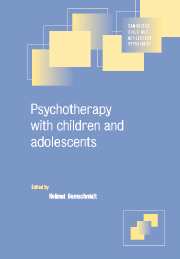Book contents
- Frontmatter
- Contents
- List of contributors
- Preface
- Part I Principles of psychotherapy with children, adolescents and families
- 1 Definition, classification and principles of application
- 2 Treatment planning
- 3 Psychotherapy research
- 4 Quality assurance
- Part II Psychotherapeutic methods and settings
- Part III The practice of psychotherapy for specific disorders in childhood and adolescence
- Part IV The practice of psychotherapy in various settings
- Index
1 - Definition, classification and principles of application
- Frontmatter
- Contents
- List of contributors
- Preface
- Part I Principles of psychotherapy with children, adolescents and families
- 1 Definition, classification and principles of application
- 2 Treatment planning
- 3 Psychotherapy research
- 4 Quality assurance
- Part II Psychotherapeutic methods and settings
- Part III The practice of psychotherapy for specific disorders in childhood and adolescence
- Part IV The practice of psychotherapy in various settings
- Index
Summary
General considerations and conceptual issues
Psychotherapy is treatment using psychological techniques, and must be distinguished from other types of treatment. Whilst it is easy to distinguish psychotherapy from techniques such as medication or physical therapy, it is more difficult to distinguish psychotherapy from approaches such as special education, occupational therapy, vocational training and encouragement and education. Placebo studies have shown that psychological factors play a significant role in all types of treatment, including those using medication. Should, therefore, any method of influencing someone by psychological means be then considered a ‘psychotherapy’? The answer to this question is clearly ‘no’. There are countless psychological factors which influence children and adolescents every day, and no one would suggest that all these should be considered to be psychotherapy. Nevertheless, the question in not absurd. In the course of the recent ‘psychoboom’, many groups and individuals have discovered that the human mind is itself a ‘psychomarketplace’. Today, a profusion of different treatment methods are being offered, many of which call themselves ‘psychotherapy’, e.g. art therapy, music therapy, dance therapy. Such terms may in some cases be appropriate if the technique is based on a clear concept, if treatment goals are defined and if a reliable method is used to attain the goals. Ideally, these methods should be based on rational considerations and the efficacy should be measurable (Bergin and Garfield, 1994). Only those approaches to treatment psychotherapy that meet these requirements are discussed in this book.
When psychotherapeutic methods are applied, the following basic principles need to be respected (Remschmidt, 1982, 1988).
- Type
- Chapter
- Information
- Psychotherapy with Children and Adolescents , pp. 3 - 11Publisher: Cambridge University PressPrint publication year: 2001
- 1
- Cited by

